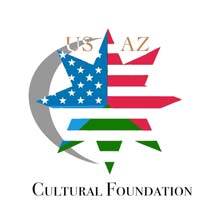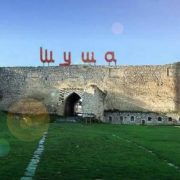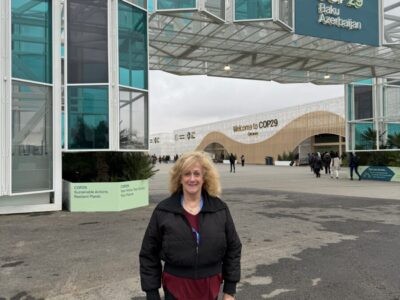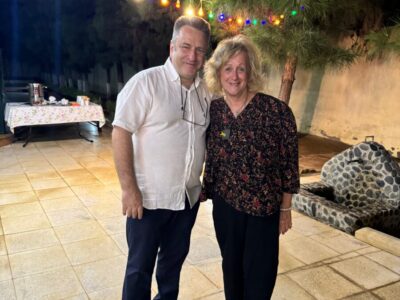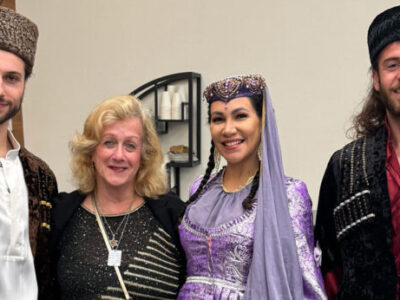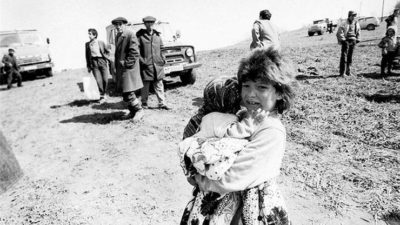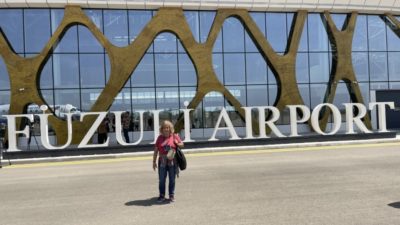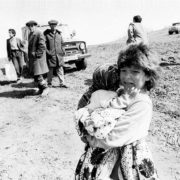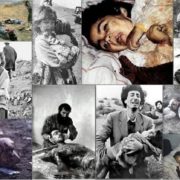Azerbaijan’s Jewry is a Jewel.
Growing up in Israel, Arabs, not Muslims, were the enemies of Israel, and thus the Jews. When it became clear to me, perhaps to others as well, that Arabs are of the Islam faith, no matter where they resided they were the enemies of Israel and thus the Jews.
When I first visited Azerbaijan, a majority Muslim country, a new reality turned the tables on me. This Muslim country was not an enemy of Israel nor the Jews, rather, it has been a safe haven for Jews during many centuries. More so, since Azerbaijan parted from the Soviet Union and declared its independence, the country holds a close friendship and relations with the only Jewish state, Israel.
That premise of Jewish life in Azerbaijan and the recent festivities of Chanukah, a Holiday in which Jews celebrate liberty and light over darkness, is the base of this 2-part essay.
I enlisted Mr. Fuad Akhundov, a history buff, Igor Shauliv Director of the Mountain Jews Museum, located in the Red Village and Mr. Yevgeny Brenneysen, an Azerbaijani Jew and my friend, to assist me in telling the story of Jewish life in Azerbaijan in ancient times, prior to the Soviet invasion, during and post-Soviet rule.


There are two prong histories of the Jews in Azerbaijan.
The first prong is the Guba’s Red Village Mountain Jews.
The second one, in 19th century, is the immigration of Jews to Baku during the oil boom that occurred in Azerbaijan.
First History Prong: The Mountain Jews of Guba (Quba)
The mountain Jews, allegedly moved to the area from what is now Iran. Another version claims that they are the descendants of the Khazar Kingdom, located in what is now the Republic of Dagestan, in the north of Azerbaijan.
After Cyrus II of Persia, whose victorious wars included both what is today modern Azerbaijan and the former Babylonian kingdom territory, founded the Achaemenid Empire, the first Persian Empire, in 550 BCE, Jews Settled all over the Achaemenid Empire.
The ancient Persian Empire was based in Western Asia. It had reached its greatest extent under Xerxes I, the Great, the fourth King of the Achaemenid Empire, ruling from 486 to 465 BCE, the son and successor of Darius the Great and Atossa, the daughter of Cyrus the Great, the founder of the Achaemenid Empire.
Xerxes I conquered most of northern and central ancient Greece.
In the year 586 BCE, King Nebuchadnezzar of Babylonia conquered the city of Jerusalem, destroyed the Temple and sent many of the inhabitants of Judah into exile in Babylon. As told in the Biblical Book of Esther, in 538 BCE King Cyrus II made a public declaration granting the exiled Jews the right to return to Judah and rebuild the Temple in Jerusalem. Some of the exiled Jews of Babylon returned to their homeland; others, who achieved economic, political and social significant echelon, remained in the Achaemenid Empire.
In the 2nd century BC, the Great Silk Road, the main trade artery connecting China with Europe, Central Asia, the Near and Middle East, a significant part of it passed through the territory of today’s Azerbaijan, was paved.
Since Jews have always been pioneers in the development of new markets, they certainly did not miss the opportunity to operate in trade in the Silk Road hubs to include what is today’s Azerbaijan.
In the 3rd century A.D., Rabbi Safra at-Derbendi mentioned the area in connection with Jerusalem. During the 8th century A.D. historians attest to rich Jewish life in the area.
After Nader Shah Afshar, who ruled Persia, including the Guba district, from 1736 to 1747, was assassinated, Persian influence in the region declined. For half a century dukes, constantly fighting with each other, ruled the vast territory.

Duke Feth-Ali Khan of Guba, who ruled the area from 1758-1789, decided to invite the Jews, scattered in politically devastated Persia, to his district where the Gudiyal-chay river flows. He divided the district along the river banks; on the river’s right bank Muslims can live and on the river’s left bank Jews can live, what became Mountain Jews Red Village. The village was made of nine neighborhoods, each named after the region location or a village from where the Jews arrived, attesting to their origin. Ali Khan’s calculation was, increased population and thus increased tax revenue and loyalty while offering the least intrusive environment.
Till the late 19th century Guba’s Jewish Village, in 1926 under the Communists renamed ‘Red Village,’ provided a safe haven for the Jews to practice their ancient culture and religion, with 11 synagogues, at least one in each of the nine neighborhoods. Though rather isolated, by the late 19th century Guba was known by the name the ‘Jerusalem of the Caucasus.’

Second History Prong: Baku Oil Boom – 1872-1920 – and The Jews
The Russian Tsarist Empire period in Baku started in 1806-till-1917.
The beginning of the oil boom in Baku started when Russia introduced oil concessions. The population grew fast. In 1872 Baku’s population was 14,000; in 1902, 143,000; in 1913, 214,000, and that fast growth doubled every 8-to-10 years.
Baku was ethnically divided into multiple groups; the four major ones included: Azeris, 34%; Russians, 36%; Armenians, 19%. All together it was almost 90% of the city’s population. Nearly half of the remaining 10% plus was made up of Ashkenazim Jews. Meanwhile, being 4.5% of Baku’s population, the local Jews provided almost 40% of the practicing medical doctors and over 30% of the lawyers.
Baku’s European Jewish community was the largest in the South Caucasus. One may reasonably think that what brought the Jews to Baku was the oil boom economy and Baku’s renaissance. In fact, by 1901, Baku was producing over 50% of the world’s crude demands while local Jewish entrepreneurs controlled up to 11% of Baku’s oil business.
While Baku’s major Oil Company was the Nobel Oil Group, the second largest was the Rothschild Caspian Black Sea Oil Corporation. The Rothschild Corporation’s field manager was David Landau, a Jew, the father of Lev (Leon) Landau, the 1962 Nobel Prize winner in Physics.
Historic parallel, at no surprise: some 100 years ago, with money Jews earned from Baku’s oil industry they bought land in what is today the state of Israel. Today, 40% of Israel’s oil needs is supplied to the Jewish state from Baku’s oil wells.
Nonetheless, there was something beyond the oil and wealth that lured mainly Ashkenazi* Jews from all over the Russian Empire to Baku. With almost 10,000 strong Jewish community by 1913 Baku was totally alien to the very concept of the Jewish ghetto. While the Azeris, Armenians and even Russians resident had kind of ‘ethnic neighborhoods,’ there was never a “Jewish quarter” [Ghetto] in Baku, nor were the Jews restricted or marginalized. The local Jewish community was evenly dispersed all over the city, absorbed into the city’s fabric. However, due to the Pale of Settlement Tsarist rule, at that time Jews did not purchase property, rather, rented it. (*Ashkenazi Jews, are a Jewish diaspora population who coalesced in the Holy Roman Empire around the end of the first millennium and in the Middle Ages moved into northern Europe beginning with Germany and France.)
Baku was outside the infamous Russian Pale of Settlement* and the Jews presence in Baku could have been legally challenged at the whim of the Imperial Russian bureaucrat. Therefore, when the major Synagogue was built in Baku, around 1910, in order not to expose the Jew living outside the Pale of Settlement the land was provided by Baku’s Municipality at no charge. (*Pale of Settlement was a western region of the Russian Empire with varying borders that existed from 1791 to 1917 in which permanent residency by Jews was allowed and beyond which Jewish residency, permanent or temporary, was mostly forbidden.)

Despite the Imperial authorities imposing obstacles, by the 1900’s Baku became the largest Zionism center in the eastern part of the Russian Empire. In the early 1910’s, the ‘Palestine Society’ was active in Baku. With the booming economy, the local Jews made remittances to procure land in the Jordan River’s banks of Palestine.
Russian Revolution Period
The Soviet Union period in Baku began in 1920-till-1991.
Since there were no economic grounds for a social revolution, and they were treated as the “society’s elite,” Baku’s Jews never produced problematic revolutionaries. i.e. Leon Trotsky* (*a Ukrainian-Russian Marxist revolutionary, political theorist and politician, ideologically a communist, who developed a variant of Marxism which has become known as Trotskyism) and Yakov Sverdlov* (*Yakov Sverdlov, a Bolshevik Party administrator and chairman of the All-Russian Central Executive Committee, sometimes regarded as the first head of state of the Soviet Union). The Baku Jewish community produced scholars, scientists, musicians, artists and educators.
In between the Russian empire rule and the Soviet rule Azerbaijan enjoyed two years of independence as the Azerbaijan Democratic Republic (ADR), from 1918 to 1920.
During that period, in 1918, Dr. Yevsey Gindes, a Jew from Kiev, Ukraine, nicknamed “The Babies’ God,” was one of Azerbaijan’s first Healthcare and Social Security Ministers, serving in ADR.
During the Soviet rule period, they imposed a policy of removing Jews from their traditional religious practice. With the Soviets’ aggressiveness, atrocities and anti-religion propaganda, all religions were affected; mosques, churches and synagogues were shut down, some desecrated but not destroyed. Only one synagogue remained open and Jewish religious rituals and practices, such as brit-milah, bar mitzvah, wedding, were practiced clandestinely.
Though the Soviet Union opposed religion, the conditions in Baku the atmosphere was rather favorable. In the 1920s, the USSR Soviet authorities imposed the use of the Cyrillic script, a writing system used for various languages across Eurasia, used as the national script in various Slavic, Turkic, Mongolic, Uralic, Caucasian and Iranic-speaking countries in Southeastern Europe, Eastern Europe, the Caucasus, Central Asia, North Asia and East Asia.
Jews began to receive education in secular schools. Many mountain Jews began to move from the ‘Red Village’ remote settlement to Baku and other major cities in Azerbaijan and the USSR.
The Soviets created education programs that promoted the emancipation of Baku’s women. They established a conservatory, educational institutes and universities in which there was a niche for Jews to fill. More so, with all the surrounding negativity the Soviet rule created an academic period in Baku which gave the Baku Jews an opportunity to prosper intellectually and become professors, actors, musicians, scientists. Additionally, the Guba Jews received education as well.
Yakov Keilikhis, (1872-1950) and Pinkhos Sabsay (1893-1980), both Odessa-born Jews, were among the first sculptors in Soviet Azerbaijan. While the former was behind the first monument in Baku, dedicated to Mirza Alakbar Sabir, a highly revered Azerbaijani satire poet, the latter is considered among the founding fathers of Azerbaijan’s monumental sculpture.
Despite a very tough communist ideology attitude toward religions, the numerous academic and educational institutions established by the Soviets turned the Soviet period into, one might say, academic and artistic renaissance for the Jews in Azerbaijan. This led to my interviewee Fuad Akhundov making a profoundly interesting conclusion: “Azerbaijan’s Jewry is Azerbaijan’s Jewelry.”
During WWII, in the face of enormous human casualties, Stalin released his grip on religion allowing to reopen some mosques and churches. This was exactly the time when two synagogues, in the vicinity of one another, were consecrated in Baku, for the European and the Mountain Jews respectively. Initially, they were operating in modified premises, originally not designed for a synagogue. When Azerbaijan gained its independence the buildings were built anew with the land designated for the Mountain Jews’ Synagogue, once again provided by the Azerbaijani Government.

The Story of One Ukraine Origin Jewish Family
My friend Yevgeny Brenneysen’s mother, from Belarus and father from the Ukraine worked in the Ukraine phosphate Chemical Plant where the chemical engineer deputy manager was from Baku. He lured the Brenneysens to move to Sumgayit, a satellite city of Baku. In 1963, when Yevgeny was seven-year-old, his family arrived to Baku to work at the Sumgayit Petrochemical Company.
Already in the early 19th century Jews began escaping pogroms in the Russian empire, such as the Kishinev Pogrom (https://en.wikipedia.org/wiki/Kishinev_pogrom), now modern Moldova, to safe haven Baku.
For instance, at the end of the 19th century, after the Vitebsk, a city in northeast Belarus, pogrom, Yevgeny’s wife Djamila’s great-grandmother moved to Baku with her family; her grandmother was already born in 1901 in Baku.

When attending school, Yevgeny never faced Antisemitism, anti-Jewish sentiments or who is who among the students. There was never a question about nationality among the students. All of them were citizens of Azerbaijan with equal rights and opportunities.
It was an inclusive society and being Jewish did not matter. Many of the schools’ teachers were Jewish and some school principals were Jews.
Due to economic downturn and lack of jobs, while the Soviets were still present in Baku they somewhat relaxed the borders and many Azerbaijani Jews moved to Israel and some to the United States. Nevertheless, their numbers were comparatively low when compared to the Jews’ departure from other Soviet Union satellites.
Post-Soviet Rule
In 1990, then-President Heydar Aliyev, the third President of Azerbaijan, from October 1993 to October 2003, started reviving the life of all Azerbaijan’s ethnic groups. He was once asked about the Jews to reply: my kids are treated by Jewish doctors.
At that time the first Jewish Association was established, Jewish organizations were founded and synagogues were renovated and rededicated.

A noticeable number of Jews turned to traditional Judaism practice and a process of revival of Judaism was underway in Azerbaijan. Jewish kids began attending Jewish school and more and more Jews who were forced to abandon Judaism during the Soviet rule no longer feared admitting they were Jews or from a Jewish origin; at last Judaism and Jews were back and strong in Azerbaijan.
Though Jewish pride in Azerbaijan never really went into hiding, the newly reestablished Republic of Azerbaijan made conditions to practice one’s religion much more favorable, which has been allowing the Jewish community to flourish, let alone be proud of their country.
This essay’s part II covers current Jewish life in Azerbaijan.
